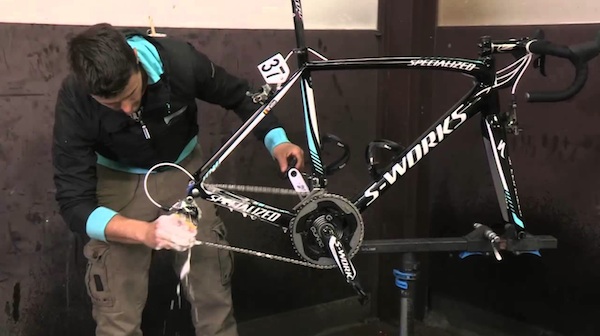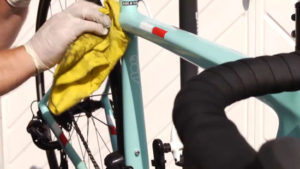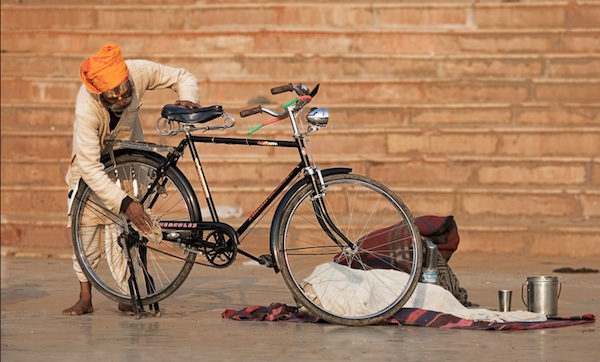Having a clean bike that looks good and works flawlessly is something that all pro riders have for every single ride. Their trick though is that they have a mechanic who keeps their bike looking and working like new. You too can have that clean, smooth working bike without spending ages working on it after every ride. The trick is to know what to do and having everything set-up and ready to use when you clean your bike.

Washing
After a ride in the rain, mud, or other gnarly elements, using water on your bike is the easiest way to get your bike clean. It gets the big stuff off without having to wipe your bike a million times with a towel or rag.
The Hose Approach
If you have a hose, leave it set up so all you have to do is turn on the water and hose down your bike. Leave the wheels on as you aren’t doing a top to bottom scrub. You just want to hose everything off and get the grit out of the nooks and crannies. Do a once over on the whole bike but when you get to the drivetrain put the spray on the chain and run the pedals backwards. After a few revolutions, keep spinning the pedals backwards but move the spray to the cassette and then the pulley wheels on the rear derailleur. Also get both brakes good.
The Bucket Approach
If you don’t have a hose, a bucket is your next best alternative. Get a sponge, or an old t-shirt, and get it sopping wet and wipe down the bike starting with the handle bars, then frame, then wheels, and then drive train to get to progressively dirtier and dirtier areas of the bike. You’ll have to ring out the sponge, or t-shirt, a few times depending on how dirty your bike is. When you get to the drivetrain you’ll spin the pedals backwards with the sponge in your other hand cupping the chain. This will get a good bit of any gunk that has built up off. Then scrub what you can off both derailleurs. After you are done scrubbing, take the remaining water and dump it slowly over the whole bike washing away anything that was left behind.
Wiping Down
If your bike wasn’t too dirty you didn’t have to hose down or use a bucket luckily. Whether you just used water on your bike or it wasn’t too dirty, you will now wipe down the bike. The best approach to this is to get a dry rag and some simple degreaser. Start with the dry rag and run it over the shifters and handle bars. Then spray a little degreaser (such as Simple Green which is light enough on everything) on a corner of the rag and wipe down the frame, scrubbing a little where it needs it. The degreaser will easily remove any dirt and grime on the bike and leave it shining like a pro’s bike. After you’ve gone over the frame, go over the rims but since you still want ample use of your brakes, don’t wipe the braking surface since the degreaser is quite slippery. A little bit won’t hurt it though if you do accidentally rub a little bit on it.
Next is the drivetrain. Take the degreaser and spray a little on both the front and rear derailleurs in their smallest gear and then again in the biggest. This allows the degreaser to get into the moving parts. Then wipe down both. Now that your rag has a descent amount of degreaser on it, run the chain backwards with the rag grasped around it. This will help to get it clean and shiny again. If you used a bit too much degreaser, take another clean dry rag and wipe down the bike again as you don’t want a slippery frame. Doing this will get your bike looking clean. How long it stays clean though is up to you.
Lubing the Chain
A smooth working bike, provided you’ve taken proper care of it with parts that aren’t too warn out, keeps it staying smooth and feeling like new due to proper lubrication. You should lube your chain every few rides at least but definitely after cleaning your bike. Since you already ran the chain through a rag when you were cleaning the bike you don’t have to do that again. If you didn’t and you’re just lubing the chain, run the chain backwards through a rag.
Take your bottle of lube and tilt the bottle slightly placing the nozzle so it just touches the top of the chain and a single drop comes out of the bottle. Now turn the pedals backwards getting roughly a drop on each link. The key to lubing a chain is that you want the lube inside the pins, not on the surface. Once you’ve gone around one to three times depending upon how dry you chain is, take the bottle away but continue running the pedals backwards. This will help to get the lube inside the chain itself. Now take a rag and run the chain backwards once again wiping off any excess lube. Your chain should now look sparkling clean.
Smooth Shifting
To keep your shifting working smooth you now want to put the bike in its biggest gear and then littlest putting a few drops of lube at all of the pivot points. Shift the gears from the biggest to the smallest and vice-versa a couple of times and then wipe off any excess lube. Now, assuming you have old school cables, flip your bike upside down, taking care not to scratch the shifters, and put a couple drops of lube underneath the bottom bracket on the cables where they slide through the plastic sleeves. Many bikes today have different cable routing designs so you’ll have to look at your bike and see where the friction points occur. They are going to be right around here where they make the bends to their respective derailleurs. Once you do this shift through all the gears a few times and add a few more drops if needed.
Now you have a clean, well-oiled machine that you obtained with minimal effort. Keep your sponges, rags, degreaser, and lube together in a convenient spot where you can grab it and be done with it five minutes after your ride. And if your bike tends to get a bit more dirty, keep a hose or bucket handy so you can do a once over on it quickly while still in your kit. Not only will you now show up on all your rides with a bike that looks like a pro mechanic took care of, it’ll work like one did too. Keeping your bike clean and lubed will also help your parts last longer too!
 It’s partly psychological, but a clean bike just seems to ride better. Some cyclists clean their bikes after every ride. Some clean their bike only when it’s dirty. It’s a given that, if you can see dirt and gunk on your bike, it needs to be cleaned. But too much water is not a good thing. And with the onset of winter, it’s almost impossible to wash your bike with soap and water, and then expect it to dry instead of freeze. Maybe a dry wash is all it needs.
It’s partly psychological, but a clean bike just seems to ride better. Some cyclists clean their bikes after every ride. Some clean their bike only when it’s dirty. It’s a given that, if you can see dirt and gunk on your bike, it needs to be cleaned. But too much water is not a good thing. And with the onset of winter, it’s almost impossible to wash your bike with soap and water, and then expect it to dry instead of freeze. Maybe a dry wash is all it needs.